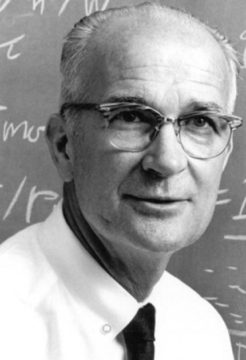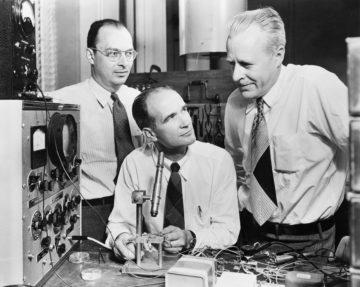by David Kordahl

Most people who know about William Shockley are likely to describe him as a eugenicist, though it’s a question of taste whether they present this aspect of his character before or after they call him the father of the transistor. The first full-length Shockley biography, Broken Genius: The Rise and Fall of William Shockley (2006), by Joel N. Shurkin, made sure, from its title onward, that readers would understand that there was something deeply wrong with Shockley as a human being, despite his scientific achievements. Shurkin went so far as to describe Shockley’s life as a tragedy, and named the three sections of Broken Genius with a pseudo-Grecian heaviness: Moira (fate), Hubris (pride), and Nemesis (retribution).
Well, given Shockley’s late-in-life focus on human “dysgenics,” who could disagree? It turns out that Bo Lojek, an engineer and the author of a new study, William Shockley: The Will to Think (2021), could disagree—and for similar reasons to why many of us, in recent years, have taken issue with the cancellation of one or another of our problematic faves. “The issue with William Shockley,” Lojek writes, “is that his scientific achievements outweigh by far any of his views we might see as objectionable.” Throughout his book, Lojek hints he’s not so sure that Shockley’s views are worthy of censure, either—but more on that in a bit.
For those readers who are unfamiliar with Shockley, it might be helpful to recap the standard view of Shockley as a sort of villain, the view that is presented by Shurkin in Broken Genius, before considering the revisionist, heroic Shockley that Lojek gives us in The Will to Think.
 In Shurkin’s version, Shockley was a nasty little boy who became a nasty little man. The first pages of Broken Genius tell us about the little boy, William, whose violent temper gave his parents much grief, but who, after an unsettled childhood, eventually gained some semblance of discipline in the Palo Alto Military Academy. He skipped middle school and breezed through Hollywood High. After a year at the local state college (which would later become UCLA), Shockley transferred to the California Institute of Technology, where physics research had flourished under the leadership of Robert Millikan (he of the “oil-drop experiment” fame).
In Shurkin’s version, Shockley was a nasty little boy who became a nasty little man. The first pages of Broken Genius tell us about the little boy, William, whose violent temper gave his parents much grief, but who, after an unsettled childhood, eventually gained some semblance of discipline in the Palo Alto Military Academy. He skipped middle school and breezed through Hollywood High. After a year at the local state college (which would later become UCLA), Shockley transferred to the California Institute of Technology, where physics research had flourished under the leadership of Robert Millikan (he of the “oil-drop experiment” fame).
Even before his ultimate triumph with the junction transistor, as Shockley moved from Caltech to MIT to Bell Labs, he showed early signs of brilliance—but Shurkin foregrounds the personal. Shockley married early (a shotgun wedding?) and became the father of three children, all of whom would eventually become estranged from him. He was not a natural family man. His second marriage would be happy, but only because Emmy Shockley supported Bill unfailingly, regardless of his alienating decisions.
But one reads a Shockley biography less for the personal details than for the astonishing career. William Shockley independently developed a prototype nuclear reactor for Bell Labs, overlapping the work of Enrico Fermi for the Manhattan Project. This work was immediately classified, a dead end, but World War 2 brought other opportunities. Shockley was recruited to analyze how the US might bomb submarines more effectively, and, upon finding success with this research (Shurkin reports that Shockley’s suggestions led to five times as many subs being destroyed), he studied how airstrikes on Japan might be deployed for the greatest devastation. This work earned him the National Medal of Merit in 1946.
Once the war had ended, Shockley returned to Bell Labs, where he completed the work that would cement his legacy. Everyone agrees that Shockley was a bad supervisor, ungenerous and competitive with those whose work he was supposed to supervise, but there was no question that his insights were a necessary factor in his group’s eventual victories.

The Bell Labs publicity photo for the production of the transistor demonstrates Shockley’s paired vices and virtues. In the photo, Shockley has seated himself at the bench while John Bardeen and Walter Brattain, the two men who actually constructed the first transistor, stand idly to his left and right—a prime example of the ungenerous supervisor taking all the glory for himself. But Shockley’s virtue, if that is the right word, was one of invention. He was so enraged at his own non-involvement in Bardeen and Brattain’s achievement that he went home and, concentrating all his intellectual powers, managed to invent the junction transistor without any input from Bardeen and Brattain—both of whom he worked to sideline from semiconductor physics from that point onward. (Famously, John Bardeen would leave Bell Labs to develop a theory of superconductivity that would win him a second Nobel Prize.)
Then Shockley had his midlife crisis. Within a few years, he left Bell Labs, moved back to California to start his own company, got divorced and remarried, won the Nobel Prize, and had most of his employees quit. Which was all very dramatic, but doesn’t explain what happened next.
What caused Shockley to become such an avid eugenicist? If there is one main criticism I might levy at the storytelling in Broken Genius, it’s that the book never takes Shockley seriously enough to ask the question. The best it does is to point out that Shockley was in a serious car accident in 1961 and never quite seems to have recovered. A few pages after his accident, Shockley shows up at the Nobel Conference at Gustavus Adolphus College in rural Minnesota to lecture the press about how troubling it was that genetically inferior humans seemed to reproduce more quickly than genetically superior ones, which he worried would lead to an “anti-evolutionary effect.” In Broken Genius, exactly why this became the beginning of his decades-long campaign remains psychologically murky.
To be fair, Shurkin does show us just how nutty this looked from the outside, making it clear why Shockley’s colleagues felt the need to distance themselves from him. Shockley may have felt himself just to be making scientific suggestions (from his 1980 Playboy interview: “Every time I have discussed the Voluntary Sterilization Bonus Plan, I have described it carefully as a thinking exercise rather than as a legislative proposal”), but no one should be surprised by the controversies that exploded when his “thinking exercises” suggested that people should be paid $1,000 per IQ-point-below-100 not to procreate, especially given his insistence that persistent racial IQ gaps were likely to be rooted in genetics.
Whatever its flaws, William Shockley: The Will to Think manages to fill in some of the gaps left unfilled by Broken Genius. If Broken Genius suffers from a lack of identification with its subject, The Will to Think suffers from the opposite problem. Bo Lojek reminds us throughout the book that he is not a historian, but is, like Shockley, a physicist-turned-engineer:
I met William Shockley and his [second] wife, Emmy, for the first time as a boy. He was a wise and decorated man, and to me, of course, seemingly an old man. Shockley’s teaching methods were severe, sometimes brutal. Equally severe and ruthless was his criticism. But I was fascinated with the exquisite way he explained complicated problems with his specific humor. He was bright and truly ingenious, with a quick grasp of new ideas.
This paragraph does not lead to any further anecdotes (and surely there is a story here—how, “as a boy,” does one meet William Shockley?), but it demonstrates Lojek’s attitude. He has not attempted to write a critical biography. Instead, the book is more like a collage, filled with reproductions of source materials—lab notebooks, publicity photos, scientific plots—all to bolster the reputation of a man who, as Lojek admiringly puts it, “never accepted the status quo.”
To be frank, I’m not sure I could have followed The Will to Think had I not read Broken Genius first. Lojek has written an eccentric and sloppy book. Each chapter is headed by an epigraph, and some chapters are grouped by theme rather than by chronology. Chapter 5, “Jean and Emmy,” takes its epigraph from The Guernsey Literary Society (I assume this is a typo for The Guernsey Literary and Potato Peel Pie Society) and attempts to cover the whole of Shockley’s personal life in seven pages.
To see just how unabashedly Lojek takes on Shockley’s point of view, consider this description of Jean, Shockley’s first wife:
Jean was not a good student and she never pursued any higher intellectual goal. Her only interest was bird-watching. She expected someone else to make decisions for her and her world reduced to reading Reader’s Digest. Jean assumed that children were a gift from God and that God would raise her children. She never disciplined the children. Bill, on the contrary, believed that discipline is not only good for children, but is necessary for their happiness and self-discipline.
This is a bizarre string of statements to pass off simply as unattributed facts. In his attempts to present Shockley’s version of things, Lojek unwittingly reminds us just why many people didn’t like Bill Shockley.
 Through The Will to Think is far from evenhanded, it makes a decent case for Shockley’s scientific contributions, and against Shockley’s scientific enemies. Of the “traitorous eight” who left Shockley’s Palo Alto startup to found Fairchild Semiconductor, Lojek writes, “By today’s business standards Gordon Moore and his comrades would certainly face a judge.” But what I found most illuminating of Shockley’s character were the parts of the story that Broken Genius left out—the pieces that might help to explain how, after the car crash, Shockley came to assume his final form.
Through The Will to Think is far from evenhanded, it makes a decent case for Shockley’s scientific contributions, and against Shockley’s scientific enemies. Of the “traitorous eight” who left Shockley’s Palo Alto startup to found Fairchild Semiconductor, Lojek writes, “By today’s business standards Gordon Moore and his comrades would certainly face a judge.” But what I found most illuminating of Shockley’s character were the parts of the story that Broken Genius left out—the pieces that might help to explain how, after the car crash, Shockley came to assume his final form.
After he began to speculate in public about “dysgenics,” Shockley began to work on lectures that he hoped might help students to improve their scientific thinking. The surprising part of this timeline was that Shockley was given a grant to improve education among disadvantaged minorities despite his controversial remarks. His curriculum was tried, and it didn’t work. As a result, his views hardened, and he concluded that racial problems in education were based on genetics, and not environment.
Now, Lojek leaves little doubt that, at some level, he agrees with Shockley about this. As he writes in the last paragraph of his book, “The ultimate question the reader should ask is: ‘What if [Shockley] was right?’” I need to be clear that I don’t think this is the ultimate question a reader should ask. But thinking about Shockley’s trials with teaching science to students who had been flagged as “disadvantaged” helped to vivify my mental model of William Shockley, to retell his story in terms I could understand.
Shockley clearly supposed, at some point, that it might be possible to teach others to think like he did. Lojek reproduces the illustrations Shockley produced to illustrate his “CSP” (Creative Search Pattern), with flowchart arrows pointing between terms like “Question,” “Familiarity,” and “Payoff hunch!” The puzzle, here, is how anyone other than Shockley himself might have become convinced that such a system might work.
After Shockley learned that it was not, in fact, so easy to reproduce his own mental habits in others, he beat the drum of genetics more insistently.
At age sixty-eight, in an incident that would be repeated in all his obituaries about a decade later, Shockley donated to the Repository for Germinal Choice, a sperm bank for purported geniuses. This was a goofy thing to do, but perhaps made some sense for a man who had convinced himself that the future of human intelligence was on the line, and that the only way to make more people like himself was to make more people.
![]() Shockley has now been dead for over thirty years, so is there any reason to reconsider the man and his views? Shurkin and Lojek agree that Shockley reshaped the world, with the guts of every computer a silent testament to his influence. But his race-baiting made him such a pariah in the scientific community that his work on semiconductors has become hard to appreciate in isolation. No one, for instance, is reprinting his masterpiece, Electrons and Holes in Semiconductors (though of course it’s easy to find a PDF), and Lojek is resigned to make Shockley’s case to a world that will surely reject him.
Shockley has now been dead for over thirty years, so is there any reason to reconsider the man and his views? Shurkin and Lojek agree that Shockley reshaped the world, with the guts of every computer a silent testament to his influence. But his race-baiting made him such a pariah in the scientific community that his work on semiconductors has become hard to appreciate in isolation. No one, for instance, is reprinting his masterpiece, Electrons and Holes in Semiconductors (though of course it’s easy to find a PDF), and Lojek is resigned to make Shockley’s case to a world that will surely reject him.
Yet there’s a troubling lack of closure to the Shockley Eugenics Saga. It’s easy enough to scowl at Bo Lojek and yell, “Listen, old man: your hero, Shockley—he was racist!” But even if he was (and of course he was), denunciations alone won’t convince readers who suspect that Shockley was on the right track.
The easiest rebuttal to Shockley—a rebuttal in a counterfactual world—would be to point, three decades on, at all the closing of racial gaps, the righting of historical wrongs, the slicing of Gordian knots. Unfortunately, we do not live in that world. In our world, many of the racial inequalities of Shockley’s day are still distressingly common. But today few take this as evidence that major environmental changes are warranted (though I would argue that this is the most obvious inference). Instead, we are stuck making little tweaks to our curricula, hoping that our vigorous condemnations of long-dead scientists will make some sort of a difference.
